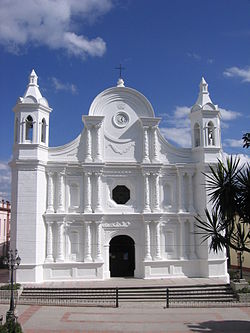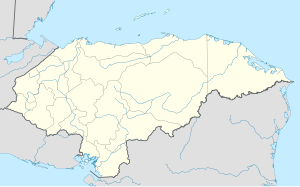Santa Rosa de Copán: Difference between revisions
No edit summary Tag: Reverted |
Largoplazo (talk | contribs) Reverted 2 edits by 190.92.19.94 (talk): WP:UNSOURCED, original research. |
||
| Line 73: | Line 73: | ||
|postal_code = |
|postal_code = |
||
|blank_name = [[Köppen climate classification|Climate]] |
|blank_name = [[Köppen climate classification|Climate]] |
||
|blank_info = [[Humid subtropical climate|Cwa]] |
|blank_info = [[Subtropical highland climate|Cwb]]/[[Humid subtropical climate|Cwa]] |
||
|website = |
|website = |
||
|footnotes = |
|footnotes = |
||
| Line 92: | Line 92: | ||
==Climate== |
==Climate== |
||
Santa Rosa |
Under the [[Köppen climate classification]], Santa Rosa has a [[subtropical highland climate]] (''Cwb'') that closely borders a [[humid subtropical climate]] (''Cwa''). Temperatures are relatively consistent year throughout the course of the year and the town is not as hot as other locations in the tropics because of the its altitude. Like other locations with this climate, there is a pronounced drier season during the “winter” months. The location sees on average roughly 1500mm of precipitation annually. |
||
Santa Rosa is known for its rapidly changing weather. Locals say that all four seasons can be experienced in one day, similar to [[São Paulo]], Brazil. In the morning, when winds blow from the ocean, the weather can be cool or sometimes even cold. When the sun hits its peak, the weather can be extremely dry and hot. When the sun sets, the cold wind comes back bringing cool temperatures. This phenomenon happens usually in the winter. |
|||
{{Weather box |
{{Weather box |
||
| Line 112: | Line 111: | ||
|Dec record high C = 26.9 |
|Dec record high C = 26.9 |
||
|year record high C = 32.3 |
|year record high C = 32.3 |
||
|Jan high C = 22. |
|Jan high C = 22.1 |
||
|Feb high C = 23. |
|Feb high C = 23.9 |
||
|Mar high C = 26. |
|Mar high C = 26.5 |
||
|Apr high C = 28.1 |
|Apr high C = 28.1 |
||
|May high C = 28.1 |
|May high C = 28.1 |
||
| Line 122: | Line 121: | ||
|Sep high C = 25.7 |
|Sep high C = 25.7 |
||
|Oct high C = 24.1 |
|Oct high C = 24.1 |
||
|Nov high C = 22. |
|Nov high C = 22.7 |
||
|Dec high C = 21.9 |
|Dec high C = 21.9 |
||
|year high C = 25. |
|year high C = 25.1 |
||
|Jan mean C = 17.6 |
|Jan mean C = 17.6 |
||
|Feb mean C = 18.4 |
|Feb mean C = 18.4 |
||
Revision as of 12:57, 17 April 2022
This article needs additional citations for verification. (June 2021) |
Santa Rosa de Copán | |
|---|---|
Municipality | |
 Cathedral of Saint Rose of Copan | |
| Coordinates: 14°46′N 88°47′W / 14.767°N 88.783°W | |
| Country | Honduras |
| Department | Copán |
| Established as city | 12 April 1843 |
| Area | |
• Total | 306 km2 (118 sq mi) |
| Population (2020 projection)[1] | |
• Total | 70,757 |
| • Density | 230/km2 (600/sq mi) |
| Climate | Cwb/Cwa |
Santa Rosa de Copán (Spanish pronunciation: [ˈsanta ˈrosa ðe koˈpan]) is a municipality in Honduras. The city of Santa Rosa de Copán is the municipal seat and the departmental capital of the Honduran department of Copán. It is located approximately 1,150 metres (3,773 ft) above mean sea level.
Santa Rosa de Copán is the largest and most important city in western Honduras with a population of 57,820 (2020 calculation).[2] Santa Rosa is the governmental hub of the department of Copán. The city is connected through the International Highway of the West (CA-4) with San Pedro Sula to the North and with the borders of El Salvador at El Poy and Guatemala at Agua Caliente to the west. Santa Rosa has a subtropical climate with temperatures ranging from 25 °C (77 °F) to 29 °C (84 °F) in the summer (March–June), and from 13 °C (55 °F) to 15 °C (59 °F) in the winter (December–February).
The historical centre of Santa Rosa de Copán has been declared a Honduran national monument, with preservation of its Republican or Neoclassical architecture and cobblestone streets that has its origins in a prosperous tobacco farming industry of the 18th century. Santa Rosa is situated at a strategic point between Copán Ruinas and Gracias, Lempira and the Celaque National Park. As before, tobacco farming remains a staple of the local economy, particularly the cultivation of premium cigar tobaccos. The La Flor de Copán cigar factory is located in the city.
History
The town was founded in the early 18th century. On 8 August 1705, the Spanish colonial captain Don Juan García de la Candelaria acquired the area then called "Los Llanos" from the Spanish crown and founded his estate with four ranches, later the first settlers named it Santa Rosa, and later Santa Rosa de Los Llanos. A tobacco industry developed in the early 18th Century and in 1765 the town was picked as the site for La Real Factoria del Tabacos, the Royal Tobacco Company, a Spanish crown company. Later, the Gracias a Dios Department was split in two departments, becoming Copán department and Lempira department.
The town was on various occasions the capital of the State of Honduras. On 7 May 1862 the nation's President Don Victoriano Castellanos Cortes, issued Legislative Decree No. 3, giving the country the title of "Republic of Honduras" instead of "State of Honduras." In 1865, the town was renamed Santa Rosa de Copán.
Its Catedral de Santa Rosa, dedicated to Saint Rosa, is the cathedral episcopal see of the Roman Catholic Diocese of Santa Rosa de Copán (established on 1916.02.02).
Climate
Under the Köppen climate classification, Santa Rosa has a subtropical highland climate (Cwb) that closely borders a humid subtropical climate (Cwa). Temperatures are relatively consistent year throughout the course of the year and the town is not as hot as other locations in the tropics because of the its altitude. Like other locations with this climate, there is a pronounced drier season during the “winter” months. The location sees on average roughly 1500mm of precipitation annually.
| Climate data for Santa Rosa, Honduras | |||||||||||||
|---|---|---|---|---|---|---|---|---|---|---|---|---|---|
| Month | Jan | Feb | Mar | Apr | May | Jun | Jul | Aug | Sep | Oct | Nov | Dec | Year |
| Record high °C (°F) | 27.6 (81.7) |
29.7 (85.5) |
32.1 (89.8) |
32.3 (90.1) |
31.8 (89.2) |
29.3 (84.7) |
27.3 (81.1) |
27.6 (81.7) |
28.2 (82.8) |
27.3 (81.1) |
27.3 (81.1) |
26.9 (80.4) |
32.3 (90.1) |
| Mean daily maximum °C (°F) | 22.1 (71.8) |
23.9 (75.0) |
26.5 (79.7) |
28.1 (82.6) |
28.1 (82.6) |
26.6 (79.9) |
25.5 (77.9) |
25.8 (78.4) |
25.7 (78.3) |
24.1 (75.4) |
22.7 (72.9) |
21.9 (71.4) |
25.1 (77.2) |
| Daily mean °C (°F) | 17.6 (63.7) |
18.4 (65.1) |
20.4 (68.7) |
21.5 (70.7) |
21.9 (71.4) |
21.5 (70.7) |
21.0 (69.8) |
21.2 (70.2) |
21.0 (69.8) |
19.9 (67.8) |
18.7 (65.7) |
17.9 (64.2) |
20.1 (68.2) |
| Mean daily minimum °C (°F) | 13.3 (55.9) |
12.9 (55.2) |
13.8 (56.8) |
15.0 (59.0) |
16.2 (61.2) |
17.4 (63.3) |
17.0 (62.6) |
17.1 (62.8) |
17.2 (63.0) |
16.4 (61.5) |
15.0 (59.0) |
13.9 (57.0) |
15.4 (59.7) |
| Record low °C (°F) | 8.0 (46.4) |
7.9 (46.2) |
8.8 (47.8) |
9.9 (49.8) |
11.2 (52.2) |
14.8 (58.6) |
14.5 (58.1) |
14.5 (58.1) |
14.5 (58.1) |
12.3 (54.1) |
10.1 (50.2) |
8.6 (47.5) |
7.9 (46.2) |
| Average precipitation mm (inches) | 39.9 (1.57) |
29.2 (1.15) |
24.1 (0.95) |
43.6 (1.72) |
153.5 (6.04) |
288.4 (11.35) |
210.7 (8.30) |
215.8 (8.50) |
295.6 (11.64) |
145.1 (5.71) |
76.3 (3.00) |
58.4 (2.30) |
1,580.6 (62.23) |
| Average precipitation days (≥ 1.0 mm) | 6 | 5 | 3 | 4 | 9 | 16 | 15 | 15 | 16 | 12 | 9 | 8 | 118 |
| Source: NOAA[3] | |||||||||||||
Sports
Football club Deportes Savio has been playing in the Honduran National league since 2007 and play their home matches at the Estadio Sergio Antonio Reyes.
See also
References
- ^ Citypopulation.de Population of departments and municipalities in Honduras
- ^ Citypopulation.de Population of cities in Honduras
- ^ "Santa Rosa C. Climate Normals 1961–1990". National Oceanic and Atmospheric Administration. Retrieved 24 January 2016.
External links
Bibliography
- Urquía Fuentes, José Leonardo. History de Santa Rosa de Copán, "Los Llanos", (chronological historical essay) 2010.


